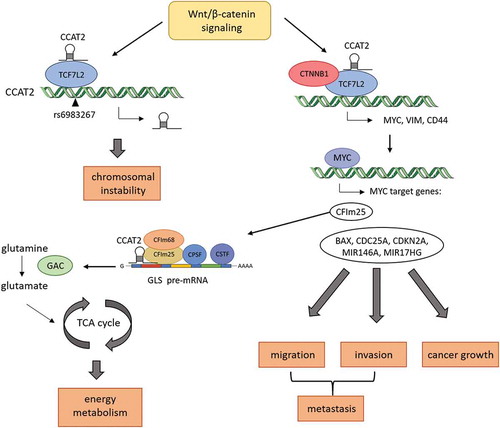Figures & data
Figure 1. Regulatory network of CCAT2 in colorectal cancer (CRC). CCAT2-induced chromosomal instability in CRC. CCAT2 enhances the expression of MYC, VIM, and CD44 via direct interaction with TCF7L2 (transcription factor 7 like 2) of the Wnt/ß-catenin pathway. CCAT2 itself is regulated via a TCF7L2-dependent feedback pathway. MYC target genes subsequently induce cancer growth, migration, invasion, and metastasis. Another MYC target gene called CFIm25 is part of the CFIm complex, which is involved in splicing of pre-mRNAs. CFIm25 assists in the alternative splicing of glutaminase (GLS) into the C isoform (GAC), which has increased activity for the deamination of glutamine to glutamate. Glutamate replenishes the intermediates of the TCA cycle, boosting energy metabolism.

Table 1. List of cancers with described CCAT2 involvement. CCAT2 was upregulated in all of the listed cancers. This table shows which clinical properties are correlated with upregulation of CCAT2 in the given type of cancer. Furthermore, it shows what kind of properties associated with cancer hallmarks are increased or inhibited and which signaling pathway is connected with these changes (OS = overall survival, TNM = tumor node metastasis staging, EMT = epithelial to mesenchymal transition).
